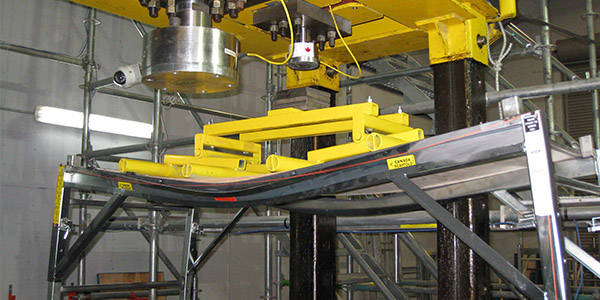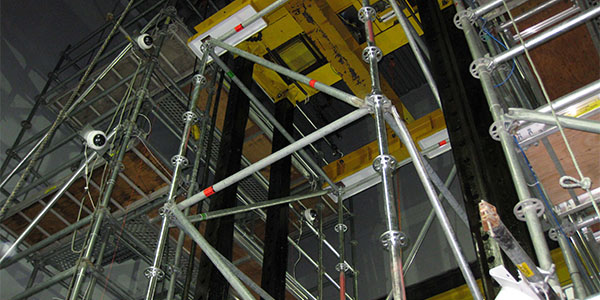Scaffold testing is used to check that a scaffold is structurally stable and safe. Scaffold tests are carried out to ensure that the scaffold has enough strength to withstand the various loads and pressures that scaffolds are subjected to during construction activities. It is important to regularly test and inspect scaffolds to avoid any accidents and that the scaffold is safe to use.
Types of Scaffolding Test Methods
Load Testing
The static load test is a test that is used to determine if the scaffold can safely support the workers, equipment, and materials in the work area. Here is a description of the procedures, devices, and considerations associated with this test.

Machinery required for load testing:
- Load Cell: A device to measure the load applied
- Hydraulic jacks: used to apply controlled loads on the scaffold
- Digital Load Indicator: Where the user can read the loads applied
- Data Acquisition System: A system for recording and analyzing load-bearing tests
- Safety equipment: helmets, safety belts, gloves and other necessary personal protective equipment (PPE) for test personnel.
Preparation:
- Verify that the scaffolding has been assembled correctly.
- Ensure the load cell is positioned in the correct locations.
- Apply load to the system using a hydraulic jack.
Calibration:
- Calibrate the load cell and display so that the load can be measured accurately.
- Before you begin your tests, check to make sure that things are functioning as they should be.
Load Application:
- Use a hydraulic jack to apply the load in a piecemeal manner, beginning with a low load and gradually increasing the load (e.g. 5-10% of the anticipated maximum load).
- Record the load applied and the classified datasets at each increment.
Observation and Documentation:
- Monitor the scaffold for signs of deformation or instability.
- Record data from the indicator and load cells at each increment.
Analyze:
- Evaluate the data to determine the carrying capacity of the load.
- Recognize if there are any obvious points of failure or weakness.
- Review the data with safety concerns in mind to verify that the standards in the manual have been met.
Important Notes
- Safety precautions: Personnel must wear protective gear and establish a safety perimeter around the testing site.
- Environmental conditions: Tests must be conducted in controlled environmental conditions to ensure validity of the test results.
- Documentation: For the test process the test should be recorded, including the equipment used, load increments, observations, and test results, with a systematic and orderly description.
- Compliance: Compliance with the relevant international standards and regulations, such as OSHA regulations, to justify the accuracy and correctness of the test results.
Stability Test
The stability test is an essential test to evaluate the stability of the scaffold, and its strength against different applied conditions. This test evaluates the scaffold’s capability to remain stable, and prevent itself from disintegration.

Machines required for stability testing
- Inclinometer: utilized to measure angle of incline/displacement
- Wind Load Simulator: tool used to introduce lateral loads to assess the stability of the system in wind conditions
- Load Cells: devices utilized to measure the magnitude of the force applied
- Data Acquisition System: device used to record and analyze testing data
- Safety equipment: includes safety helmets, safety belts, gloves etc. used by the operators in test condition.
Preparation:
- Confirm that the scaffolding is correctly set out and that all connections are secure.
- Fit inclinometers to various parts of the scaffolding.
- A wind load simulator was attached to test the scaffold under wind conditions.
Calibration:
- Adjust inclinometers and load cells to ensure they are correctly positioned and establishing a reliable measurement of the forces experienced.
- Carry out a basic equipment check of all tools and instruments.
Application of force:
- First use the wind load simulator trying capacities of wind loading with lateral forces of 10% of the MAXIMUM loadings.
- By making small settings (e.g. an additional 10% on the simulated instrument) adjust the force you place on the wind load simulator and watch the inclinometer reading for any movement.
- Make a note of the instabilities that are apparent by recording your observations of the forces at this point.
Observation and records:
- The scaffold and any means of increased height are observed for any sign of distortion, tilting, moving, or bulging.
- Each time an augmentation was made, data from the inclinometer and the load cell are recorded.
Analyze:
- The collected data underwent analysis to find the reached critical stability threshold.
- Determine the components, or aspects of a component, which are the weakest and cause instability.
- Finally, each set of data we output was verified in comparison to the safety standards to ensure the scaffold complied.
Important Notes
- Safety Precautions: Make sure all employees are using the relevant safety equipment and enforce the safety perimeters around the testing area.
- Environmental Conditions: Tests are only carried out in supervised circumstances to ensure any results obtained will have precision.
- Documentation: Keep record of the testing procedure full of equipment, increment of forces, observations, and outcomes.
- Compliance: Follow any regulations or standards related to the testing, abiding by OSHA regulations for accurate testing results.
Component Testing
Component testing is essential for ensuring the integrity and usability of individual scaffold components. Component testing verifies that each part is able to safely support the structure.

Machinery needed for component testing
- Universal Testing Machine (UTM): tests the strength and endurance of individual components under various loads.
- Micrometer: Measures the size and thickness of parts.
- Durometer: Tests the hardness and elasticity of a material.
- Corrosion testing machine: Tests the resistance of a metal part for corrosion.
- Data acquisition system: used to record and analyze testing data.
- Safety equipment: hard hats, gloves, and any other equipment for the testers.
Prepare:
- Choose individual components of the scaffold (i.e., brackets, connectors, planks) which are required.
- Visually look at the scaffold components for any obvious damage.
- Set up, and calibrate, the test equipment to ensure accurate results.
Size test:
- Micrometers should be used to measure the dimensions and thickness of each part, and data can is then compared with industry specified tolerances they have to adhere to.
Strength test:
- The component is mounted to a universal testing machine and load is then applied in increments to evaluate the strength and load carrying capacity of the component and to observe deformations or failure of the component by recording the load at which deformation or failure occurs.
Hardness Testing:
- Use a hardness tester to measure the resistance of a material to deformation. Make a note of the hardness value and compare it to industry standards.
Corrosion testing:
- Use a corrosion tester to perform corrosion checks on metal components. Be sure to simulate environmental conditions such as a salt spray to identify how corrosion-resistant a material performs under those conditions. Measure and compare the amount of corrosion to acceptable limits.
Observe and record:
- During testing, make observations of the components for any deformations, wear, or failure that may occur.
- During each stage of testing, record the data of the testing equipment.
Analyze:
- The data that you record will be analyzed in order to calculate the strength, durability, and resistance of each component. Identifying any components, which are not in compliance with safety or performance standards.
- Finally, compare the data to the industry standards and safety regulations to ensure that the components meet the requirements.
Important Notes
- Safety tips: make sure personnel dress in the proper safety gear and go through the proper safety tips while performing any testing.
- Documentation: List all equipment, your observations, and your results from the testing.
- Regulations: Met the standards and regulations so that the results are valid.
Security Check
Safety inspections are important to ensure the structural integrity and safety of the scaffold during its use. These inspections can help detect potential hazards and verify the soundness of all components.
Tools Needed For Safety Inspection
- A checklist with instructions for the entire scaffold assembly.
- A tape measure to ensure the parts are made to size and positioned correctly.
- A level or similar tool to check for levelness and that the scaffold is constructed correctly.
- A few hand tools, such as a set of wrenches or a screwdriver, to check the security of all bolts and connections.
- A flashlight or similar tool for any parts of the scaffold that may be difficult to see.
- A camera or similar tool to take photographs of the scaffold.
- Personal protective gear for the inspector. -Hard hat, gloves, etc.
Initial inspection:
- Conduct behavior before using scaffolding.
- Make sure the scaffolding has been assembled correctly as per the manufacturer's instructions.
- Check to ensure all the components are there and there are no obvious defects present in them.
Routine inspection:
- Inspect the scaffolding periodically (daily or weekly, for example) for the duration of the project.
- Inspect the base plate and bottom mudsills to ensure proper support is there and the scaffold level.
- Examine all connections and tighten any loose bolts or screws.
Component inspection:
- Examine each plank to look for fractures, separations or excessive wear.
- Confirm that the guardrail, midrail, and toeboard are installed and secured.
- Check the stability of the access points and ladder and ensure they are kept securely in place.
Load Check:
- Check that the scaffold is stable and that the weight limits of the scaffold are not exceeded.
- Look at the scaffold for indications of deformation, distortion, or over extension.
Environmental Check:
- Evaluate the work area for any dangers, such as overhead wiring or ground conditions that could be unstable.
- Make sure the scaffolding is protected from the wind and rain.
Final test:
- Conduct one last review when the work is completed, or before dismantling the scaffolding.
- Document the condition of the scaffolding and any fixes that need to be made.
Important Notes
- Safety Precautions: Inspectors must adhere to safety precautions and rules and wear required safety gear during inspections.
- Frequency: Adjust the frequency of inspections based on the complexity of the job or environmental factors.
- Documentation: Ensure that all inspection documents are kept, note any issues discovered, and document any actions done to repair any issues found.
- Compliance: Be knowledgeable to only follow compliance standards. This includes following OSHA guidelines and other standards or regulations to inspect the site thoroughly.
Conclusion
Scaffolding safety quiz is a critical aspect of construction and maintenance projects, ensuring the safety, stability, and reliability of scaffolding structures. By adhering to established standards and regulations, conducting thorough inspections, and implementing best practices, construction companies can mitigate risks and prevent accidents.
FAQ
Why Is Scaffolding Inspection Important?
- Scaffolding inspection is important to ensure the safety and stability of structures, preventing accidents and ensuring compliance with regulations.
How Do You Do Scaffold Analysis?
- Scaffold analysis involves assessing structural integrity, load capacity, and safety compliance to ensure the scaffolding is fit for use.
How Often Does Scaffolding Need To Be Checked?
- Scaffolding should be checked before each use, after any alterations, and at regular intervals, typically every 7 days.
Related Resources
Scaffold-Safety-Compliance-Test.pdf --- UALR
Test Your Scaffolding Safety Knowledge --- YOUTUBE
Scaffolding, Shoring And Anchoring Systems Testing --- CLARKTESTING


